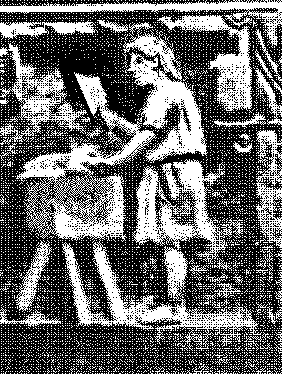
Here is a Roman butcher in action, but we will only look at meat
cutting for Canada (which is the same as the US), England, and Japan.
Cuts of beef
The first step in breaking the carcass is to separate it into primal cuts
that can be handled more easily. The primal cuts correspond fairly closely
to the units that a retail butcher might order from a wholesaler or abattoir.
The primal cuts of beef are shown below. The separation of the forequarter
and the hindquarter leaves only the last rib on the hindquarter.
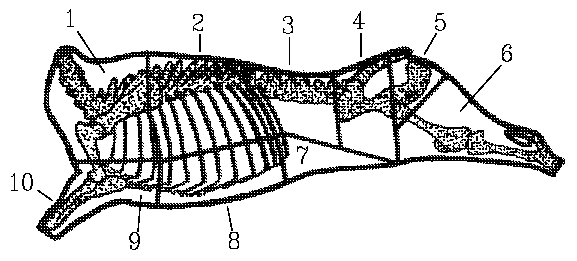
On the hanging side of beef, count seven vertebral centra down from the
sacral-lumbar junction, add on just less than the length of a half a centrum,
and cut perpendicularly through the vertebral column at this point with
a saw. Separate the forequarter from the hindquarter by cutting through
the intercostal and abdominal muscles, following the curvature of the twelth
rib. The forequarter can be dropped onto a table or held suspended by its
own hook from a hoist.
-
Separate the chuck
 from the rib
with a perpendicular cut through the vertebral column, level with the intercostal
muscles between the dorsal parts of ribs 4 and 5.
from the rib
with a perpendicular cut through the vertebral column, level with the intercostal
muscles between the dorsal parts of ribs 4 and 5.
-
Separate the rib from the
plate
by an anterior to posterior cut. This separation may be made much nearer
to the vertebral column than the shown in the diagram.
-
Separate the chuck from the brisket by a cut that is perpendicular
to the fourth rib at a point about 1 cm proximal to the olecranon process
of the elbow.
-
The shank may be cut into thick slices, the shank knuckle slices
are proximal.
-
Before breaking the hindquarter, trim off the excess fat near the pubis
and over the posterior part of the abdominal muscles. Anterior to the rectus
femoris, at a point where the tensor fascia lata muscle reaches
its most distal extent, start a separation that ends on rib 12, about 20
cm from the vertebral column. This detaches the
flank.
-
Separate the round from the rump with a cut that passes about
1 cm distal to the ischium and terminates just after passing through the
head of the femur.
-
Separate the rump from the sirloin with a
cut that passes between sacral vertebrae 4 and 5, and terminates just ventral
to the acetabulum of the pelvis.
-
Separate the sirloin from the short loin
with a cut that is perpendicular to the vertebral column and which passes
between lumbar vertebrae 5 and 6.
The primal cuts next are separated into retail cuts. Here they are given
an approximate rating according to tenderness,
* less tender cuts to braise, stew or pot roast,
** medium tender cuts, good for cooking by moist heat,
*** tender meat for roasting, broiling or frying.
-
The rib cut is separated into rib steaks*** or standing
rib roasts*** by cuts made perpendicularly to the vertebral column. Rib-eye***
or delmonico*** steaks are composed of sections of the spinalis dorsi together
with the longissimus dorsi muscle.
-
If you are new to this game, a key point to note is how to distinguish
steaks through the rib region
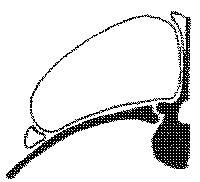
from those through the loin.
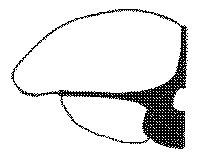
RIB versus TRANSVERSE PROCESS OF LUMBAR VERTEBRA
ONE EYE OF MEAT versus TWO EYES OF MEAT
-
The chuck is sliced in planes that are parallel to rib 4 to make blade
steaks** or blade pot roasts**.
-
Arm steaks*, arm pot roasts* or cross cut ribs*
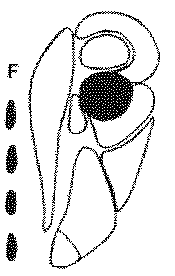 are sliced off perpendicularly to the humerus.
are sliced off perpendicularly to the humerus.
-
Brisket* is sold in chunks to be braised or cooked in liquid. The shank*
is cut into thick slices that are perpendicular to the radius and ulna.
-
The plate may be divided into cubes of rib bone and muscle, and sold as
short ribs*. The flat mass of meat located ventro-laterally to the rib
cage is usually rolled, tied, and cut into cylindrical cuts of plate*.
-
Abdominal muscles may be isolated from the flank to make flank steaks*.
-
The short loin is sliced into steaks perpendicularly to the vertebral column.
 Top loin steak with large eye of longissimus
dorsi.
Top loin steak with large eye of longissimus
dorsi.
-
The most anterior steaks are the wing or club steaks***, and nearly
all their meat is derived from the longissimus dorsi.
-
Next are the T bone steaks*** and these gain extra meat from the
psoas major towards the posterior end of the loin.
-
Last are two or three porterhouse steaks***. These have large areas
of meat derived from both the longissimus dorsi and the psoas major. In
the porterhouse region at the posterior end of the short loin, the vertebrae
can be removed from the steaks to create
New York strip steaks***
(longissimus dorsi) and tenderloin or
filet steaks*** (psoas
major and minor).
-
In a restaurant with a French menu, the longissimus dorsi may appear as
Biftek de Contre Filet and the psoas muscles as Filet Mignon.
-
The steaks cut perpendicularly to the shaft of the ilium in the
sirloin
are named by the shape of the sectioned ilium.
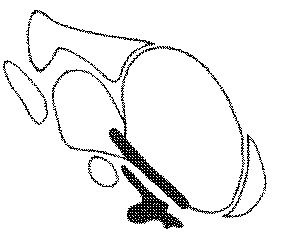
These steaks are, from anterior to posterior,
-
(1) pin bone sirloin steaks*** named from
the oval section of the anterior projection of the ilium,
-
(2) flat bone or double bone sirloin steaks*** named from the flat
sections of the wing of the ilium where it joins with the wing of the sacrum,
-
(3) round bone sirloin steaks*** named from the round sections of
the slender shaft of the ilium, and
-
(4) wedge bone sirloin steaks*** named from
the triangular cross section of the ilium near to the acetabulum.
-
The triangular shape of the rump and the complex shape of the pubis, ischium
and the head of the femur make this cut difficult to handle. If the bones
are carefully removed, slices of rump steak** may be cut quite easily,
or the cut can be left in large chunks as standing rump** or boneless rump**.
-
The round
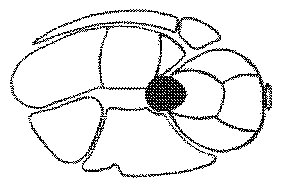 may be cut into full cut round steaks**
that are perpendicular to the femur, or it may be cut into large pieces
of meat parallel to the femur to create the inside or top round**
(mostly semimembranosus and adductor) and the outside or bottom round**
(mostly semitendinosus and biceps femoris). The semitendinosus sometimes
is detached and slices may be sold as the
eye of the round**.
may be cut into full cut round steaks**
that are perpendicular to the femur, or it may be cut into large pieces
of meat parallel to the femur to create the inside or top round**
(mostly semimembranosus and adductor) and the outside or bottom round**
(mostly semitendinosus and biceps femoris). The semitendinosus sometimes
is detached and slices may be sold as the
eye of the round**.
-
The sirloin tip** is a cut from the round that includes the muscles
which pull on the patella.
Cuts of veal
Veal carcasses are smaller than beef carcasses and there is less need to
subdivide the carcass into primal cuts. Typical primal cuts are the forequarter,
loin (from scapula to ilium), flank (from mid-sternum to tensor fascia
lata), and leg (including sirloinX). The cuts of veal are quite small,
and many of the beef names are used since the overall pattern for beef
is followed. The brisket usually is called the breast in the veal
carcass. The equivalent region to the T bone may be called a kidney
chop if the kidney has been left in place and sectioned with the chop.
Differences in tenderness between cuts of meat from various parts of the
veal carcass are far less pronounced than for the beef carcass.
Cuts of pork
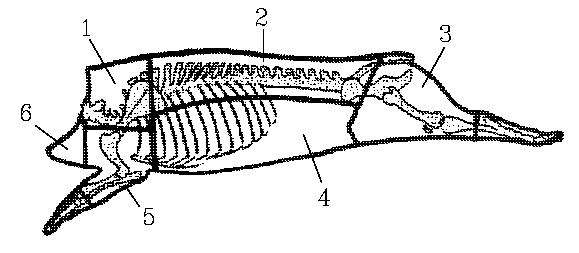
Cuts of lamb
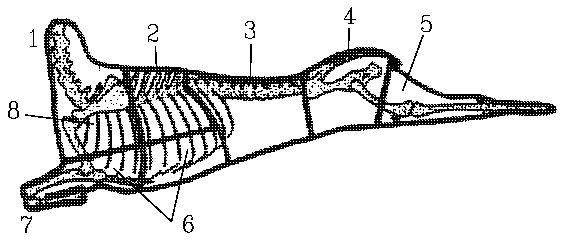
-
The sirloin plus leg, or pin bone leg, is removed by cutting perpendicularly
through the vertebral column at a point level with the anterior face of
the ilium.
-
In the lamb carcass, the loin includes part of the abdominal wall.
The loin is removed by a cut that passes between ribs 12 and 13 and which
then continues perpendicularly through the vertebral column.
-
Sometimes the whole breast and the
shank are removed with
a single cut from the anterior of the sternum to the ventral part of rib
11.
-
Alternatively, the dominant cut may be made between ribs 5 and 6, to separate
the rib from the
shoulder, and to divide the breast into
anterior and posterior sections. In the diagram, note how the
metacarpal cannon bone is fixed back so that the carcass can be more easily
transported.
Differences in the tenderness of lamb muscles may become apparent in carcasses
from older animals, and the pattern of consumer use reflects the method
of cooking required. The notation of asterisks (*) that was used for beef,
is used again in this paragraph.
-
The leg may be divided a number of ways, either into leg chops***
or steaks*** that are cut perpendicularly to the femur, or into
large or small roasting cuts. Like many other decisions made by the butcher,
seasonal preferences are taken into account. Steaks and chops are popular
in the summer while large roasts are more popular in the winter.
-
Similarly, the sirloin either may be cut into sirloin chops***,
or left as a sirloin roast***.
-
The flap of abdominal muscle on the loin is removed, and is added to the
breast meat.
-
The loin is sliced into loin chops*** or left whole as a
loin roast***.
-
The rib or rack of lamb may be subdivided into rib chops***, or
left whole as a rib roast. The rack makes an excellent crown roast when
the vertebral column is trimmed and bent back on itself.
-
There are a number of ways in which to divide the shoulder. It may be made
into blade chops***, or left largely intact as a
square shoulder
roast***. Parts of the shoulder may be be boned and rolled to make
Saratoga chops***.
-
The neck* is usually sliced perpendicularly to the vertebral column.
-
The fore shank* is removed intact, and the remaining breast* is
subdivided in an arbitrary manner.
-
Much of the fat on the breast may be removed, and the remaining lean can
be rolled or cut into riblets to conform to local preferences.
UK Meat Cutting
Imagine carrying a whole hip of beef and dropping it on a cutting block
ready to work on. It would be wise to drop it with the lateral surface
downwards onto the block to leave the aitch bone exposed and ready to remove.
Thus, the medial surface of the hip becomes the UK topside - litteraly,
it is on top. Between the semimembranosus (located medially, part of the
topside) and the semitendinosus (located laterally and equivalent to the
eye of the round in North America) is a natural seam that is opened to
remove the silverside. Thus, from the plan view below we cannot
see that the topside is medial to the silverside, much as the inside round
is medial to the outside round in North America. A final point to note
is the location of the UK spare rib of pork which corresponds to something
like a North American blade or boston shoulder. In the UK, ribs and intercostals
also are cut from the belly, but are identified separately as barbecue
spareribs.
 Beef cuts are the leg(1),
Beef cuts are the leg(1),
silverside and topside (2),
top or thick rump (3),
whole rump (4),
sirloin (5),
hindquarter flank (6),
fore rib (7),
forequarter flank (8),
middle rib (9),
brisket (10),
steakmeat (11),
clod (12),
shin (13), and
sticking (14).
Pork cuts are the
leg (15),
belly (16),
loin (17),
hand & spring (18),
blade bone (19),
spare rib (20) and
head.
However, there are many other ways to break a carcass in the UK, where
meat cutting is, or at least used to be, an elegant skill with artistic
and literary pretensions.
Dr. Johnson's morality was an English an article as a beefsteak.
Nathaniel Hawthorne.
Japanese Meat Cutting
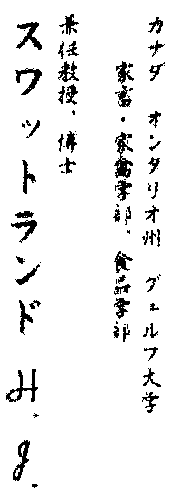 The most striking feature of Japanese meat
cutting is the complete removal of all bones and almost everything else
that is not fat or muscle - including all lymph nodes, periostium, sinews,
skin, ligamentum nuchae, and so on. Some types of Japanese beef are extremely
fat with major seams of intermuscular fat, much of which may be removed
to leave highly marbled meat that is sliced very thinly and may be cooked
rapidly at the dinner table, holding it with chopsticks and dipping it
into lightly spiced boiling water. Thanks, Masa, for my business card in
Japanese!
The most striking feature of Japanese meat
cutting is the complete removal of all bones and almost everything else
that is not fat or muscle - including all lymph nodes, periostium, sinews,
skin, ligamentum nuchae, and so on. Some types of Japanese beef are extremely
fat with major seams of intermuscular fat, much of which may be removed
to leave highly marbled meat that is sliced very thinly and may be cooked
rapidly at the dinner table, holding it with chopsticks and dipping it
into lightly spiced boiling water. Thanks, Masa, for my business card in
Japanese!
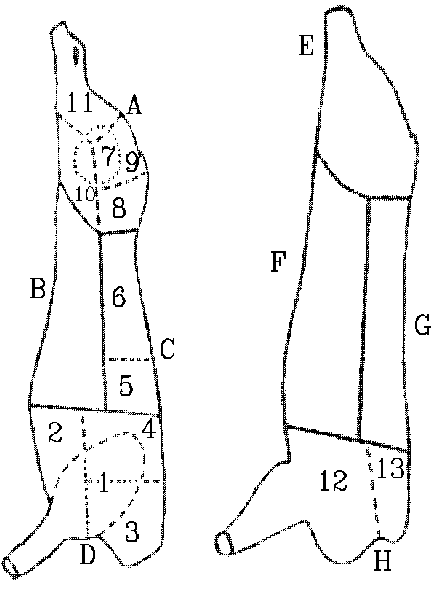 The primal beef cuts removed from
a hanging carcass are the front quarter, tomobara, loin and round. The
front quarter includes the first six ribs and may be angled slightly to
follow the rib radius of curvature (D) . The arm and shank are removed
from the front quarter much as a British butcher might remove a shoulder
of lamb, that is, by lifting humerus and scapula together while cutting
through the serratus ventralis where it attaches medially to the scapula
and then severing rhomboideus and trapezius (1). The arm and shank then
are boned out to leave the sleeve of surrounding muscles as a retail cut.
The remaining parts of the axial skeleton and musculature are separated
into what might be called a plate (rib and sternum, Figure 2), neck (cervical
vertebral region, 3), and shoulder roast (thoracic vertebral region, 4).
The primal beef cuts removed from
a hanging carcass are the front quarter, tomobara, loin and round. The
front quarter includes the first six ribs and may be angled slightly to
follow the rib radius of curvature (D) . The arm and shank are removed
from the front quarter much as a British butcher might remove a shoulder
of lamb, that is, by lifting humerus and scapula together while cutting
through the serratus ventralis where it attaches medially to the scapula
and then severing rhomboideus and trapezius (1). The arm and shank then
are boned out to leave the sleeve of surrounding muscles as a retail cut.
The remaining parts of the axial skeleton and musculature are separated
into what might be called a plate (rib and sternum, Figure 2), neck (cervical
vertebral region, 3), and shoulder roast (thoracic vertebral region, 4).
The sternum, xiphoid cartilage, ribs and costal cartilages are
removed from the tomobara (B), which is roughly equivalent to plate and
flank. The tomobara extends from rib 7 to the ilium, and contains the ventral
two thirds of rib length. The flat plate of boneless tomobara may be cut
into three slabs. Having removed the tomobara from the hanging carcass,
the psoas muscles are removed as a filet mignon.
The loin is separated into a rib and loin roasts perpendicularly to
the vertebral column (5 and 6, respectively), but there seems to be some
variability in the plane of cutting: either between thoracic vertebrae
10 and 11, or between 11 and 12.
The round (A), really more like a hind quarter, has its medial muscle
mass removed as an inside round (7). This includes the pectineus, adductor
and semimembranosus group that starts ventral to the pubis. The rump and
outside round (8 and 9, respectively) are removed along a line from the
tip of the tensor fascia lata to the tip of the semitendinosus. The quadriceps
femoris group of muscles (rectus femoris and the three vastus muscles)
is removed as the shintana (10). All that remains is the hindshank composed
of gastrocnemius and the distal extensor and flexor muscles of the hindlimb
(11).
For the pork carcass, the shoulder (H) is removed perpendicularly to
the vertebral column between thoracic vertebrae 4 and 5, while the ham
is removed at the lumbar-sacral junction (E). But sometimes the last lumbar
vertebra may be left on the ham instead of the loin roast. Psoas muscles
are removed as a filet. The roast (vertebral column and dorsal ribs, G)
is removed from the bacon (belly and ventral ribs, F) by a line parallel
to the vertebral column at about one third rib length. After boning, the
shoulder is separated into arm and shoulder roasts at a line level with
the top of the scapula (12 and 13).
Recognition of cuts of meat
-
The recognition of the species of meat when cuts of beef, pork and lamb
are displayed for sale as top-quality fresh meat is based on the color
of the lean and on the size of whole muscles and bones.
-
Beef lean has the deepest color, and pork has the lightest color.
Lamb and veal are intermediate, depending on the age of the animal. Veal
from entirely milk-fed calves is extremely pale.
-
If marbling fat is present as wavy lines and dots of white fat in
the lean, it is very conspicuous against the dark color of the lean in
beef, but is sometimes less visible in pork.
-
Pork exhibits the greatest variation in depth of color between different
muscles.
-
Pork often has the whitest fat, and beneath the subcutaneous fat
may be seen the thick cutaneous muscles of the pork carcass.
-
Some pork cuts retain their skin.
-
To identify a cut of meat, first decide whether an unidentified cut is
from the left or right side of the carcass. Then ascertain its position
and orientation in the carcass. Do not forget that left and right sides
of the carcass form mirror images, and that the two flat surfaces of a
chop or steak from one side of the carcass may also form mirror images.
This is particularly important when identifying muscles from diagrams.
-
Examine the surfaces of the cut of meat, and look for a surface that might
have been medial, as indicated by vertebrae, sternum, pubis, ribs, adductor
muscle, gracilis, etc.
-
Surfaces that were once part of the lateral surface of the carcass usually
bear traces of trimmed or untrimmed subcutaneous fat, often with a grade
stamp.
-
The orientation of a cut of meat may be indicated by the extent to which
the cut of meat is tapered. The abdomen is narrower than the thorax in
an eviscerated carcass, and the limbs are tapered from proximal to distal.
-
The dorsal spines of most of the thoracic vertebrae project posteriorly.
-
The anterior ribs are shorter than the posterior ribs.
-
Look for a series of exposed blocks of porous bone. If a deep groove (neural
canal) runs through the series, the bones are vertebrae from along the
animal's backbone. If no groove is present, the bones may be part of the
sternum. However, if a carcass has been poorly split into sides, the midline
cut may miss the neural canal.
-
Look for rounded cross sections of bone that might be from a limb, but
remember that part of the shaft of the ilium also is round in cross section.
The whole hindlimb is rounded in cross section, but the forelimb is flattened
because it is located against the rib cage. When the ilium has a rounded
cross section in a whole sirloin, the muscle mass is lop-sided, and there
is some trace of the sacrum on the edge of the cut of meat. The more posterior
part of the shaft of the ilium is triangular in cross section (wedge bone
of sirloin). When the femur has a rounded cross section in the round, ham
or hind leg, it is almost in the center of a circle of meat.
-
When the humerus or the shaft of the scapula have a rounded cross section
in the chuck or arm region, it is alongside a series of transected ribs,
and the muscle mass of the limb is oval in cross section.
-
Look for a section that has been cut through a flat bone.
-
If it is rigidly part of the body of a vertebra, and if it is narrow,
it may be a wing-like transverse process of a lumbar vertebra from the
loin.
-
If it is rigidly part of a vertebra and is dorsal to the neural canal,
and if it is one of a series of wide porous sections of bone, it may be
a dorsal spine of a thoracic vertebra from the blade or rib region of the
carcass.
-
If it is curved and if it is movably jointed to a vertebra, it is
probably the dorsal part of a rib (.
-
If it is parallel to a vertebral process, or if it is joined by cartilage
to a vertebra, it may be the flat part of the ilium from the sirloin.
-
If it is isolated by itself in the meat, or if it is shaped like
a letter T, it is probably the scapula.
-
If there are no bones in the cut of meat, and if it is a flat slab of meat
composed of several layers of flat muscles, it is probably part of the
flank or abdominal wall.
-
If the cut of meat has large vertebrae with a complex shape, and if the
outer surface of the meat is dark and ragged, the meat is probably from
the neck.
-
If the outer surface of the cut of meat contains a flat rounded area of
bone with a dimpled surface and traces of dried cartilage, the bone is
the pubis from the rump region.
-
Look for a hole in the meat where the carcass might have been suspended
from a large hook or gambrel. This indicates a hind leg, or the heel of
the round in beef. In beef, the achilles tendon is hard, dry, pale yellow
in color, and extremely strong.
-
Look for a series of parallel ribs. The anterior ribs are shorter than
the posterior ribs, and anterior ribs connect directly to the sternum.
-
Look for a long flap of muscle that runs diagonally over the medial surfaces
of the ribs. This flap of muscle is the diaphragm. The ventral part of
the diaphragm is anterior to the posterior part. In the beef carcass, the
anterior part of the diaphragm appears in the plate, and the posterior
part of the diaphragm appears at the start of the short loin, in the wing
or club steak region.
-
Look for a ball and socket joint. The socket of the scapula in the chuck
region of the carcass is wide and shallow. The socket that forms the acetabulum
of the pelvis is narrow and deep, and there may be a trace of the ligament
which holds the head of the femur into the socket. The acetabulum occurs
at the junction of the rump, the round and the sirloin. In pork and lamb,
the acetabulum may be contained in the top of the ham or leg.
-
Look for a small loose bone that would fill a cupped hand. This is the
patella of the hind limb.
-
Look for the stump of the tail, with its small, simple caudal vertebrae.
-
Look for a series of small round sections of white cartilages. These are
the costal cartilages from the plate, flank, belly or breast.
-
Look for groups of several small muscles, each surrounded by white fibrous
tissue. These are the extensor and flexor muscles from the distal part
of a limb. The Achilles tendon indicates the hind limb.
CARCASS GRADING
The primary objective of carcass grading is to describe the value of a
carcass in clearly defined terms useful to the meat industry. It is advantageous
to both the buyer and to the seller if the task of grading the carcass
is left to an impartial third party - the federal grader. If the buyer
and the seller have worked out their own system of payment for high and
for low value carcasses, they can save time or money by not having the
carcass federally graded. The federal grading of carcasses facilitates
long distance transactions and contracts for future shipments in which
one or both parties have not yet examined the carcasses.
Quantity and quality
Three major factors determine the value of a carcass relative to market
conditions, (1) carcass weight, (2) the cutability or yield of saleable
meat, and (3) the quality of the lean meat. All three factors are continuous
variables that may be measured in either absolute terms, such as weight,
or in relative terms, such as those used by a taste panel. In scientific
experiments, accurate carcass evaluation is necessary to search for minor
differences beteween carcasses. But a less accurate system is adequate
for commercial transactions, and the continuous spectrum of carcass properties
is subdivided into a relatively small number of grades in a step-wise sequence.
Thus carcasses that are placed in the same grade may exhibit small differences,
but carcasses that are placed into different grades should exhibit much
larger, and commercially significant differences.
Since 1972, the Canadian beef grading system has encouraged a tremendous
reduction in the amount of fat on beef carcasses. But, by 1987, consumer
responses indicated that the tenderness of beef was a concern and, in 1992,
the grading system was altered to include a measure of marbling and to
make it at partly compatible with USDA beef grades. The marbling is now
given by a rating for Canada's top grades.
A - must contain a least traces of marbling
AA - must contain slight marbling
AAA - contains small or greater marbling
All these A grades are from youthful animals with muscle that is bright
red, firm and fine grained and fat that is firm and white. The quality
grade (A, AA or AAA) is marked on each of the four quarters of the carcass
within a maple leaf badge.
Yield grading for Canadian beef carcasses is now a separate system.
At present (I often out of date), yield grade A1 has >59% lean, A2 has
54 to 58% lean, and A3 has <=53%. The yield grade is determined by measuring
the exterior fat, and the length and width of the rib- eye. The grader
has a special ruler. Firstly, the fat depth (mm) is measured at a single
site over the fourth quarter of the loin- eye using some notches on the
ruler although, biologically, there is no guarantee that fat is spread
uniformly all over the carcass. There are nine fat classes, the first starting
at 4 mm and the last at 20 mm of fat depth (step size = 2 mm). Next, the
ruler is used to measure the loin-eye length and width, but this is only
an approximate measurement where the dimension is taken as less than the
box marked on the ruler (measurement = 1), within the box (= 2), or greater
than the box (=3). These measurements then are used with a look-up-table
(LUT) on the ruler to obtain a muscle score. The muscle score is then used
together with the fat class in another LUT to find the estimated lean yield.
The estimated lean yield then places the carcass as either A1, A2 or A3,
which is marked all down the carcass in red ink with a roller. The lesser
grades are more simple. Grade B carcasses are all from youthful animals
that missed the A grade for one reason or another: B1 for those without
any marbling or with less than 4 mm exterior fat, B2 for those with yellow
fat, B3 for those with poor muscling, and B4 for dark-cutters. Grades D
and E, which are seldom used, are for mature cattle used for ground beef
or meat processing. The current beef grading system in Canada has only
two maturity groups.
Diagnostic features of maturity in Canadian beef grading.
YOUTHFUL
1. Cartilagenous caps on the thoracic vertebrae not more than
half ossified (T 1 to 3).
2. Lumbar vertebrae with evidence of cartilage or a red line
on the spinous process tip (L 1 to 5),
3. Red, porous spinous processes when split.
4. Narrow, round, red ribs.
5. Sternebrae not fused.
MATURE
1. Thoracic caps more than half ossified.
2. No cartilage or red line on lumbar vertebrae.
3. Hard, white, flinty spinous processes when split.
4. Wide, flat, white ribs.
5. Ossified sternum.
Pork grades in Canada
Pork grades are used in Canada to pay a producer for the amount of saleable
meat that has been produced. The system is based on the inverse linear
relationship that exists between total backfat and the percentage yield
of the ham and loin. The dorsal spines of the thoracic vertebrae remain
on the left side of the carcass when it is split into sides. The fat depth
is measured 7 cm from the midline between ribs 3 and 4 with an optical
probe. A LUT is used to calculate the grade (called the index) from a combination
of the backfat measurement and the warm carcass weight. Exceptions to the
LUT are: (1) ridgelings (cryptorchids) all grade at 67, (2) emaciated carcasses
all grade at 80, (3) 3 index points may be deducted for a badly shaped
belly, (4) 10 index points may be deducted for abnormal fat color or texture,
(5) tissue trimmed off by a meat inspector because of defects with a farm
origin reduces the carcass weight.
The farm of origin is identified by a shoulder tattoo on the pork
carcass, and the producer is paid the numerical product of the reported
market price, the grade, and the carcass weight.



 from the rib
with a perpendicular cut through the vertebral column, level with the intercostal
muscles between the dorsal parts of ribs 4 and 5.
from the rib
with a perpendicular cut through the vertebral column, level with the intercostal
muscles between the dorsal parts of ribs 4 and 5.


 are sliced off perpendicularly to the humerus.
are sliced off perpendicularly to the humerus.
 Top loin steak with large eye of longissimus
dorsi.
Top loin steak with large eye of longissimus
dorsi.

 may be cut into full cut round steaks**
that are perpendicular to the femur, or it may be cut into large pieces
of meat parallel to the femur to create the inside or top round**
(mostly semimembranosus and adductor) and the outside or bottom round**
(mostly semitendinosus and biceps femoris). The semitendinosus sometimes
is detached and slices may be sold as the
eye of the round**.
may be cut into full cut round steaks**
that are perpendicular to the femur, or it may be cut into large pieces
of meat parallel to the femur to create the inside or top round**
(mostly semimembranosus and adductor) and the outside or bottom round**
(mostly semitendinosus and biceps femoris). The semitendinosus sometimes
is detached and slices may be sold as the
eye of the round**.

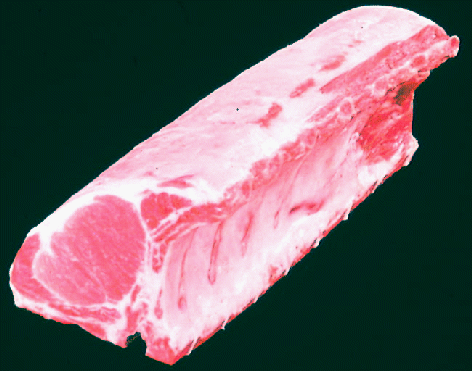
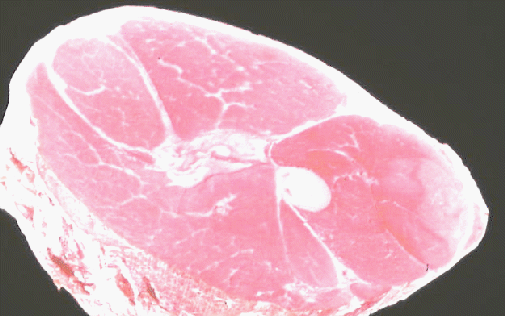

 Beef cuts are the leg(1),
Beef cuts are the leg(1),
 The most striking feature of Japanese meat
cutting is the complete removal of all bones and almost everything else
that is not fat or muscle - including all lymph nodes, periostium, sinews,
skin, ligamentum nuchae, and so on. Some types of Japanese beef are extremely
fat with major seams of intermuscular fat, much of which may be removed
to leave highly marbled meat that is sliced very thinly and may be cooked
rapidly at the dinner table, holding it with chopsticks and dipping it
into lightly spiced boiling water. Thanks, Masa, for my business card in
Japanese!
The most striking feature of Japanese meat
cutting is the complete removal of all bones and almost everything else
that is not fat or muscle - including all lymph nodes, periostium, sinews,
skin, ligamentum nuchae, and so on. Some types of Japanese beef are extremely
fat with major seams of intermuscular fat, much of which may be removed
to leave highly marbled meat that is sliced very thinly and may be cooked
rapidly at the dinner table, holding it with chopsticks and dipping it
into lightly spiced boiling water. Thanks, Masa, for my business card in
Japanese!
 The primal beef cuts removed from
a hanging carcass are the front quarter, tomobara, loin and round. The
front quarter includes the first six ribs and may be angled slightly to
follow the rib radius of curvature (D) . The arm and shank are removed
from the front quarter much as a British butcher might remove a shoulder
of lamb, that is, by lifting humerus and scapula together while cutting
through the serratus ventralis where it attaches medially to the scapula
and then severing rhomboideus and trapezius (1). The arm and shank then
are boned out to leave the sleeve of surrounding muscles as a retail cut.
The remaining parts of the axial skeleton and musculature are separated
into what might be called a plate (rib and sternum, Figure 2), neck (cervical
vertebral region, 3), and shoulder roast (thoracic vertebral region, 4).
The primal beef cuts removed from
a hanging carcass are the front quarter, tomobara, loin and round. The
front quarter includes the first six ribs and may be angled slightly to
follow the rib radius of curvature (D) . The arm and shank are removed
from the front quarter much as a British butcher might remove a shoulder
of lamb, that is, by lifting humerus and scapula together while cutting
through the serratus ventralis where it attaches medially to the scapula
and then severing rhomboideus and trapezius (1). The arm and shank then
are boned out to leave the sleeve of surrounding muscles as a retail cut.
The remaining parts of the axial skeleton and musculature are separated
into what might be called a plate (rib and sternum, Figure 2), neck (cervical
vertebral region, 3), and shoulder roast (thoracic vertebral region, 4).